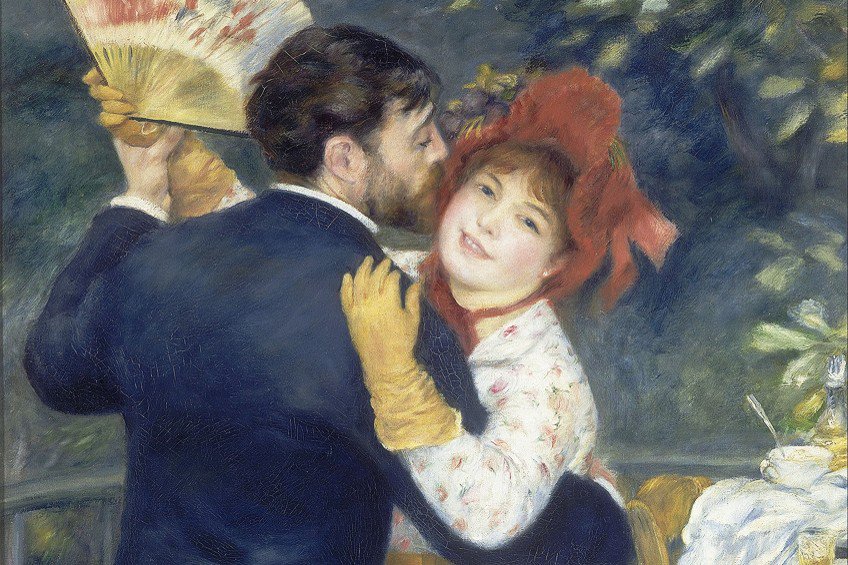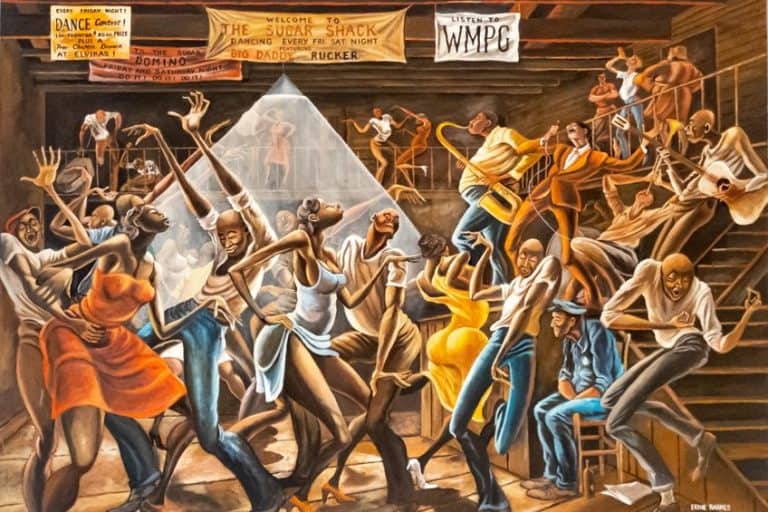“Dance in the Country” by Pierre-August Renoir – In-Depth Analysis
The scene is set. Lively music plays in the background, and as the cutlery clinks and people cheer, a couple finishing their dinner to dance the night away. This is what the painting, Dance in the Country by Pierre-August Renoir, depicts and what this article will explore and discuss!
Artist Abstract: Who Was Pierre-Auguste Renoir?
Pierre-Auguste Renoir’s date of birth was February 25, 1841, and his birthplace was Limoges in France. His date of death was December 3, 1919, and he died in Cagnes-sur-Mer in France. He was one of the well-known artists from the progressive Impressionism art movement. He worked at a porcelain factory during his teenage years, and in 1862 he studied at the École des Beaux-Arts and was also taught by artists like Charles Gleyre.
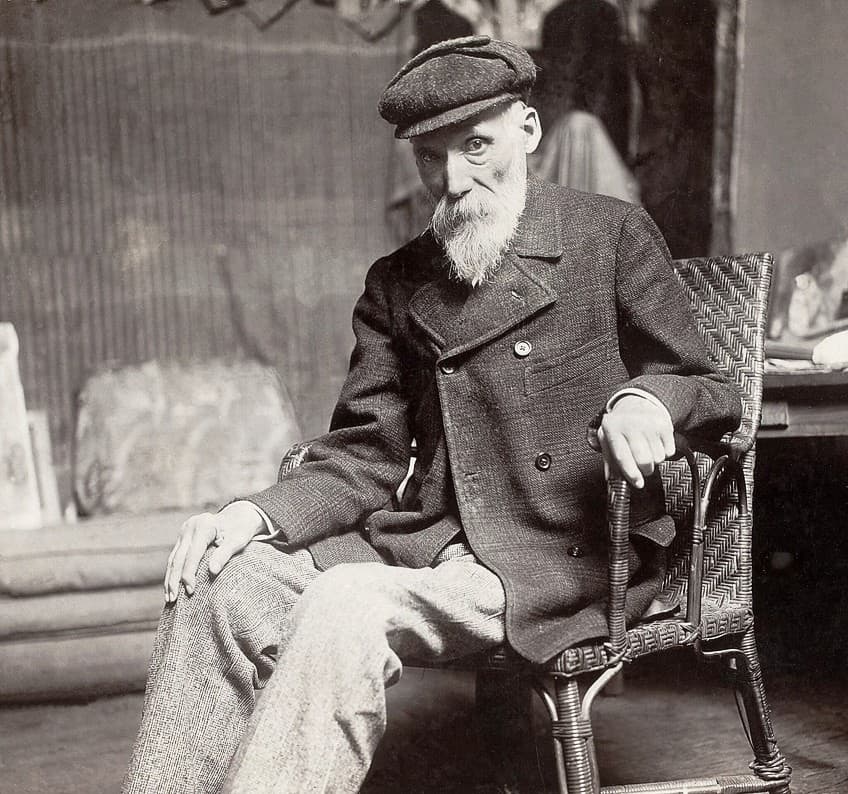
He exhibited at the Paris Salon and the Impressionist Exhibition, its debut was in 1874. His art style consisted of vibrant colors that encapsulated the effects of light and shadows, also turning to aspects of the Renaissance style in his later artworks. His subject matter was often modern everyday scenes of people and female nudes.
Some of his artworks include “Luncheon of the Boating Party” (1880 – 1881), “Two Sisters (On the Terrace)” (1881), and “Pont Neuf” (1872).
Dance in the Country (1883) by Pierre-Auguste Renoir in Context
| Artist | Pierre-Auguste Renoir (1841 – 1919) |
| Date Painted | 1883 |
| Medium | Oil on canvas |
| Genre | Genre painting |
| Period/Movement | Impressionism |
| Dimensions (cm) | 180 x 90 |
| Series/Versions | Part of a collection of three paintings with a dancing couple |
| Where Is It Housed? | Musée d’Orsay, Paris, France |
| What It Is Worth | The price is uncertain |
The article below will explore in more detail a contextual analysis of La Danse à La Campagne, or in English, The Country Dance painting by Pierre-Auguste Renoir, discussing when he painted it, who commissioned it, who the two dancers are, and other interesting facts. It will also discuss a formal analysis, which will take a closer look at the painting’s subject matter and the composition according to the elements and principles of art, which will be followed by a brief conclusion.
Contextual Analysis: A Brief Socio-Historical Overview
The Country Dance painting by Pierre-Auguste Renoir was commissioned by the French Paul Durand-Ruel around 1882. Durand-Ruel was a well-known art collector and art dealer who supported various artists, from the Barbizon School that started during the 1830s to around the 1870s and consisted of a group of artists who wanted to depict more naturalism in their paintings and often painted in the en-plein-air style, to Impressionism, the latter of which Renoir was associated with.
Durand-Ruel was an important figure in the modern art world because of his avid support of artists from the above art movements. He also held numerous exhibitions and his support put French artists on the international map.
A notable part of this was that he provided considerable financial success for the Impressionists. He bought a significant number of artworks from these artists that helped them during dire times of trying to sell their artworks.
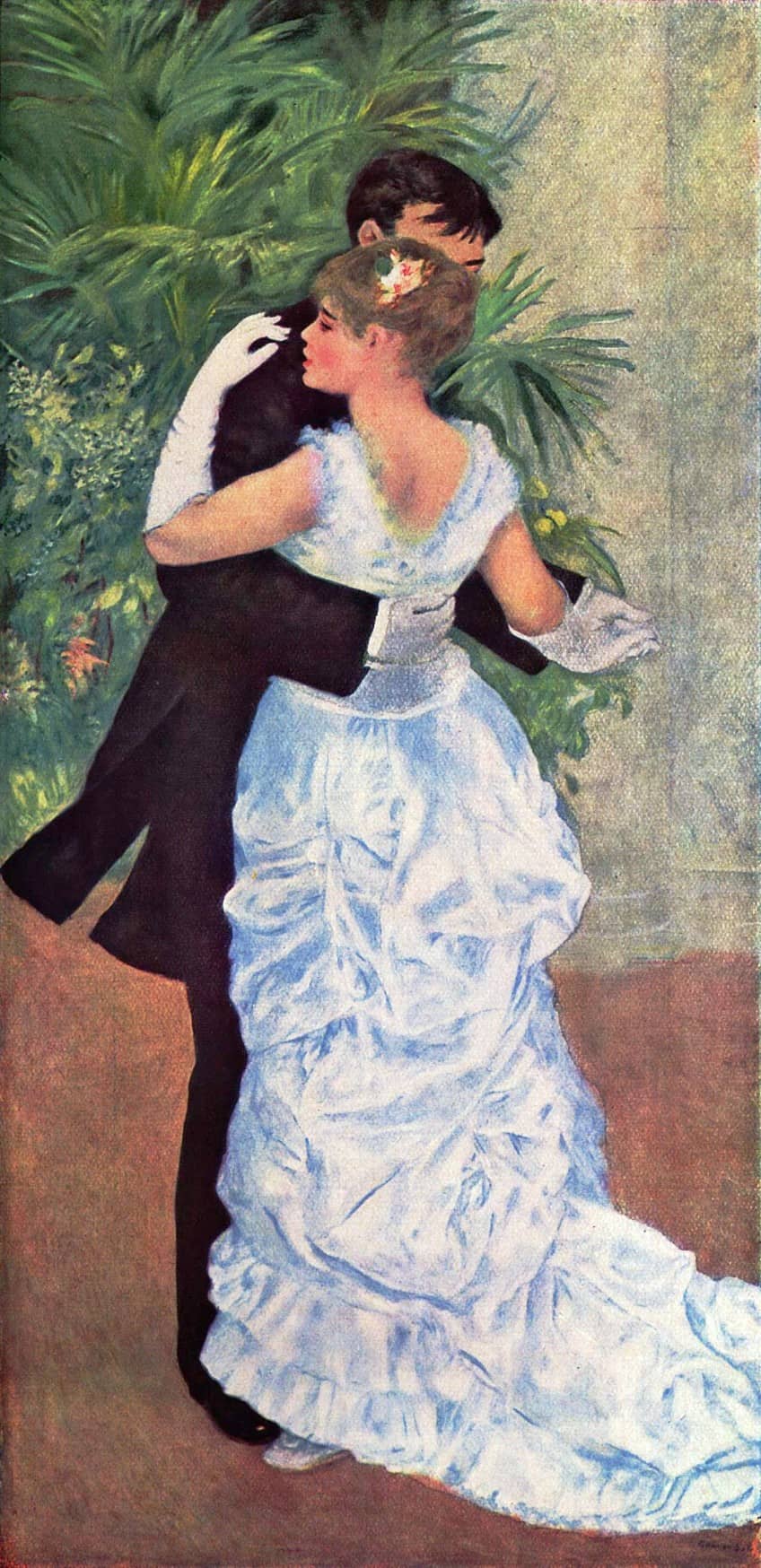
When it comes to Durand-Ruel’s commission of The Country Dance painting by Renoir, he reportedly wanted paintings that depicted a dancing couple, of which Renoir painted three life-size portraits. Reportedly, all three paintings were created during January and April of 1883.
These were portrayed in three types of settings relating to the urban and rural environments, namely, the country (as discussed in this article), which is in Musée d’Orsay in Paris, France, the city, titled Dance in the City (Danse à la Ville) (1883), which is also housed at the Musée d’Orsay in Paris, and the outdoors, titled as Dance at Bougival (La Danse à Bougival) (1883), which is housed at the Museum of Fine Arts in Boston, Massachusetts in the United States.
A Change in Renoir’s Style
A significant stylistic influence on the painting Dance in the Country by Pierre-August Renoir was the artist’s travels to Italy from 1881 to 1882. He saw artworks by Renaissance masters like Leonardo da Vinci, Titian, and Peter Paul Rubens, and studied their classical styles, notably that of Jean-Auguste-Dominique Ingres and Raphael.
Renoir grew out of the Impressionistic style of painting during this time and adopted the classical styles of more defined forms.
However, he reportedly still desired to maintain the application of colors and light in his compositions that were so characteristic of Impressionism. He wrote numerous letters to his patrons during his time in Italy talking about his processes of art making and how he was “bogged down in experiments”, and notably regarding his portrayal of the human figure and portrait painting, which changed in style and evident in his three renditions of dancing couples.
Who Are the Dancers?
Renoir did not paint strangers to model for The Country Dance painting, in fact, the man was reportedly Paul Lhôte, who was Renoir’s friend, and the woman was Aline Charigot, who was Renoir’s love interest and then his wife; the couple got married in April 1890.
Aline Charigot can be found as one of the models in several of Renoir’s other paintings, for example, in Luncheon of the Boating Party (1881), which is housed at The Phillips Collection in Washington, DC in the United States, she is the woman in the lower left corner holding the small dog. Another example includes The Great Bathers (1884 – 1887), which is housed at the Philadelphia Museum of Art in Philadelphia, United States, she is the woman in the center and near the back with blond hair.
Reportedly, Renoir had a different female model for “Dance in the City”. While the man was also Paul Lhôte, the woman was the French artist, Marie-Clémentine Valadon (usually named and known as Suzanne) who also appeared as the woman in “Dance at Bougival”.
Although, X-ray studies suggest changes to the body shape of the woman in the Dance at Bougival painting, and have determined that Renoir could have first started with Aline Charigot as the model but then changed the model to Suzanne Valadon.

It was also believed that the male model for Dance at Bougival could instead have been Hippolyte-Alphonse Fournaise, and not Paul Lhôte, because of the differences in the color of their facial hair. Interestingly, Renoir depicted his main female protagonist in The Country Dance with a smile. Reportedly, the women in the other two paintings mentioned above do not appear as convivial.
Women were a large part of Renoir’s subject matter, and numerous sources have spoken about Renoir’s personal beliefs about women, which were undoubtedly influenced by how he depicted them in his paintings. This includes the collective perception of women and their role in 19th-century society at the time, which would have also influenced Renoir.
A Later Sketch of The Country Dance
Renoir also created an etching on paper based on the same subject matter from The Country Dance painting, which is titled Dance in the Country (c. 1890). This was reportedly one of Renoir’s first etchings that he made, and he produced over 50 prints.
This etching depicts a couple dancing, however, here the woman is on the left, who was modeled by Suzanne Valadon, and the man on the right, was modeled by Edmond Renoir, the artist’s brother.
The woman has a bonnet on her head and is wearing a beautiful dress while the man sports a suit and hat. This rendition resembles the dancing couple in Renoir’s other painting, the Dance at Bougival, notably by their stance too, as the man is leading the woman who looks to her right while he faces her.
Formal Analysis: A Brief Compositional Overview
The compositional overview below will start with a description of the painting Dance in the Country by Pierre-August Renoir, which will be followed by a discussion of how each art element, namely color, texture, line, shape, form, and space, is utilized to create the visual composition.

Subject Matter: Visual Description
The Country Dance painting by Pierre-Auguste Renoir portrays a dancing couple as the two central figures of the composition. They appear to be in an exterior setting during the evening, which appears to be the terrace of a café/restaurant. This is evident due to the railing in the background where a lower level with several faces is visible, could this be another seating or dancing area?
A chestnut tree is along the upper right corner of the composition, which further gives evidence of the outside. Additionally, a table with what appears to be a finished dinner is also partly portrayed in the middle ground to the right.
The couple appears to have decided to dance after their meal on the open floor area next to their table. The man’s hat is lying on the floor on its side in the lower right corner of the foreground, could this suggest the couple is jovial and the hat could have fallen off the man’s head while dancing? Looking at the dancing couple more closely, the man is on the left. He is wearing a blue suit with black heeled shoes, and his face is in profile view, and he has a neatly groomed beard. He is leading the woman as they dance. His right arm is around her middle back and his left hand is holding her right wrist.

The woman is to the right and facing us, the viewers, and she is smiling and appears to be having a good time. She is wearing a white dress with what appears to have floral patterns on it, a brown belt around her waist, a red bonnet (interestingly, the woman in The Dance at Bougival painting also wears the same red bonnet), mustard-yellow gloves, and white shoes, as revealed by what appears to be her left foot under her dress.
She is holding a fan in her right hand while her left arm and hand are loosely positioned around the back of the man’s right arm as he guides her.
Color
Renoir’s utilization of colors in The Country Dance painting creates contrasts, for example, the lighter and warm colors, notably the soft white of the woman’s dress, the beige colors of the floor in the foreground, and the white of the tablecloth to the right. These are contrasted with the darker colors of the man’s blue suit and the evening shadows in the background.
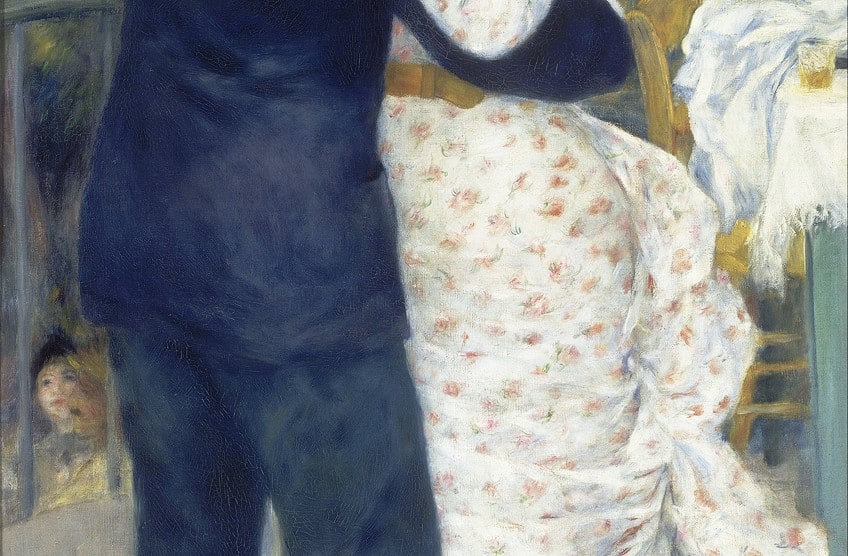
Texture
There are a variety of brushstrokes in Renoir’s The Country Dance painting, these imply the texture of the subject matter but its tactile quality on the canvas creates a sense of movement and expressiveness. Some of the brushstrokes appear almost feathery in their application, for example, the frills at the bottom of the woman’s dress, which create movement and correlate with the couple as they are moving in their dance.
Diagonal and cross-hatched brushstrokes on the hat in the lower right corner suggest its texture, which appears to be made of straw. There are also smoothed and scumbled brushstrokes that create the texture of the man’s suit.
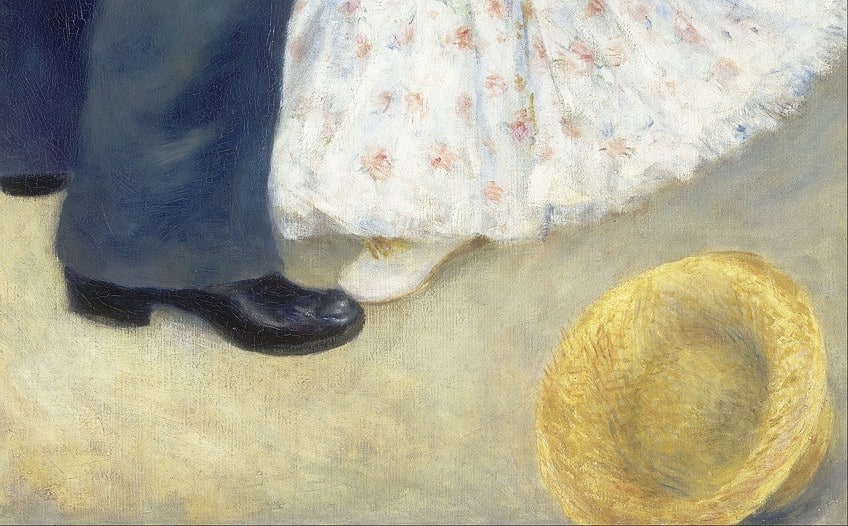
Line
There is a dominance of vertical lines in Renoir’s The Country Dance painting, which is enhanced by the two dancing figures and the orientation of the canvas, which is a portrait. There are organic lines created by curved contours as compared to more geometric or angular lines, which provide more naturalism to the composition.
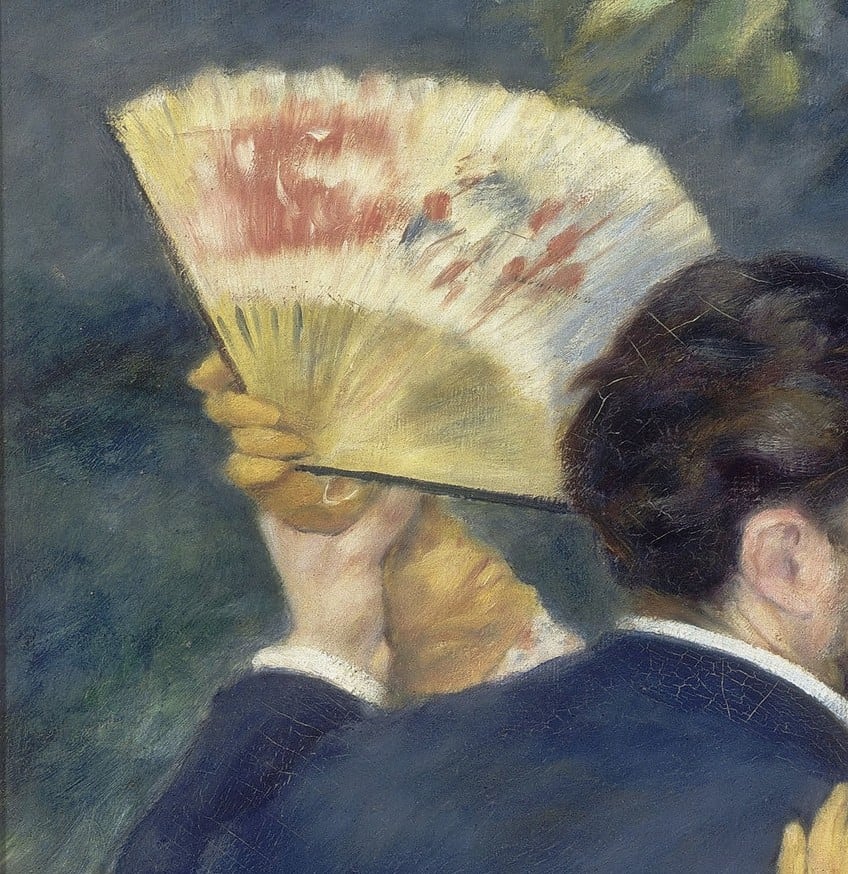
Additionally, a variety of lines are also created by the visible brushstrokes on the canvas, some are short, long, thin, thick, diagonal, horizontal, and vertical, all of which create movement and dynamism in the composition.
Shape and Form
Dance in the Country by Pierre-August Renoir consists of naturalistic curved, irregular, and sometimes described as “free-flowing” shapes and forms, which can otherwise be stated as more organic compared to a geometric or abstract composition.
Examples of some of the shapes include the oval-like shapes of the leaves on the tree to the right, the circular shape of the hat on the floor in the lower right corner, and the curved and angular shape of the fan in the woman’s hand.

Space
Regarding the subject matter, Renoir depicted an exterior space in the Dance in the Country painting, and the events taking place around the primary subject which is the dancing couple in the center. A three-dimensional space is created through techniques like scale and size and other art elements like color and line. Examples of this include the dancing couple who appear lighter in color compared to the background, which is darker, creating a highlighting effect to bring the couple into more focus.
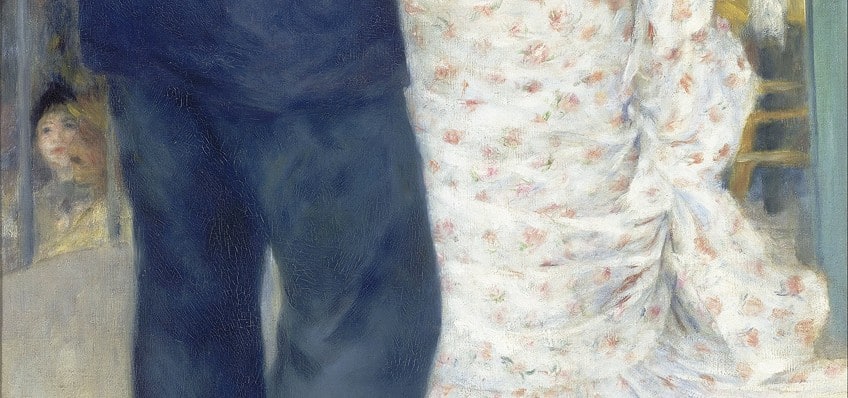
The figures in the background appear smaller than the figures in the foreground, and along with the railing that creates a seemingly dividing line, a sense of distance is conveyed and lets us, the viewers, know that the dancing couple is on a terrace.
Dancing the Night Away
Dance in the Country by Pierre-August Renoir was first exhibited in 1883 in Paris at the Durand-Ruel gallery and was owned by Durand-Ruel reportedly since 1886 although the price he paid for the commission is unclear.

The painting was reportedly in a private collection, after which it made its way to National Museums for the Jeu de Paume Museum in 1979, and then, also in 1979, it was allocated to the Louvre Museum in Paris, France, and finally the Musée d’Orsay in 1986, which is also in Paris.
“The Country Dance” painting has been in numerous exhibitions throughout the years and has been an example of Renoir’s change in style from strictly Impressionistic to more classically inspired. He notably created his figurative forms with more distinct lines, but the Impressionist color and light still seeped through as Renoir’s couple danced the night away.
Frequently Asked Questions
Who Created The Country Dance Painting?
The Country Dance (1883) oil on canvas was painted by Pierre-Auguste Renoir, who was a French painter known for being one of the Impressionists. The work measures 180 by 90 centimeters, and is a life-size portrait painting of a dancing couple after they have eaten their dinner.
What Is the Location of Dance in the Country by Pierre-August Renoir?
The oil on canvas painting, titled La Danse à La Campagne (1883) in French, by Pierre-Auguste Renoir is housed at the Musée d’Orsay in Paris, France. The museum is believed to have purchased it in 1979, although the exact price is uncertain.
Who Commissioned Dance in the Country by Pierre-August Renoir?
The art dealer, Paul Durand-Ruel, commissioned the oil on canvas Dance in the Country by Pierre-August Renoir in 1882/1883. He was one of the foremost French art dealers at the time, and supported artists like Renoir and other Impressionists.
Is Dance in the Country by Pierre-August Renoir Part of a Series?
There are three paintings that Pierre-Auguste Renoir painted that revolved around the theme of a dancing couple. These were in the city, country, and outdoors, and respectively titled Dance in the City (Danse à la Ville) (1883) in the Musée d’Orsay in Paris, Dance in the Country (1883), also at the Musée d’Orsay, and as Dance at Bougival (La Danse à Bougival) (1883) at the Museum of Fine Arts in Boston, the United States.
Who Are the Models in The Country Dance Painting?
The woman in Pierre-Auguste Renoir’s The Country Dance (1883) painting is Aline Charigot, who married the artist in April 1890 and was his partner at the time of the painting. The man was Paul Lhôte, the artist’s friend. Both models also posed in several of Renoir’s other paintings.
Alicia du Plessis is a multidisciplinary writer. She completed her Bachelor of Arts degree, majoring in Art History and Classical Civilization, as well as two Honors, namely, in Art History and Education and Development, at the University of KwaZulu-Natal, South Africa. For her main Honors project in Art History, she explored perceptions of the San Bushmen’s identity and the concept of the “Other”. She has also looked at the use of photography in art and how it has been used to portray people’s lives.
Alicia’s other areas of interest in Art History include the process of writing about Art History and how to analyze paintings. Some of her favorite art movements include Impressionism and German Expressionism. She is yet to complete her Masters in Art History (she would like to do this abroad in Europe) having given it some time to first develop more professional experience with the interest to one day lecture it too.
Alicia has been working for artincontext.com since 2021 as an author and art history expert. She has specialized in painting analysis and is covering most of our painting analysis.
Learn more about Alicia du Plessis and the Art in Context Team.
Cite this Article
Alicia, du Plessis, ““Dance in the Country” by Pierre-August Renoir – In-Depth Analysis.” Art in Context. September 21, 2023. URL: https://artincontext.org/dance-in-the-country-by-pierre-august-renoir/
du Plessis, A. (2023, 21 September). “Dance in the Country” by Pierre-August Renoir – In-Depth Analysis. Art in Context. https://artincontext.org/dance-in-the-country-by-pierre-august-renoir/
du Plessis, Alicia. ““Dance in the Country” by Pierre-August Renoir – In-Depth Analysis.” Art in Context, September 21, 2023. https://artincontext.org/dance-in-the-country-by-pierre-august-renoir/.


